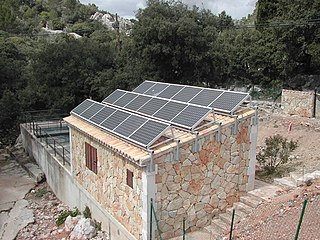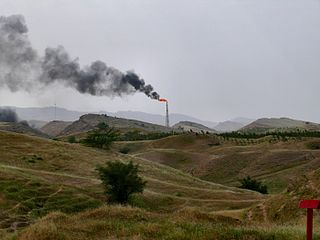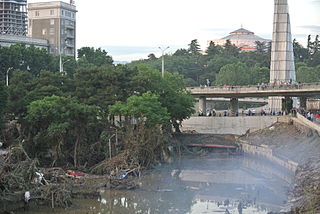Related Research Articles

Environment friendly processes, or environmental-friendly processes, are sustainability and marketing terms referring to goods and services, laws, guidelines and policies that claim reduced, minimal, or no harm upon ecosystems or the environment.
Environmental pollution in Japan has accompanied industrialization since the Meiji period. One of the earliest cases was the copper poisoning caused by drainage from the Ashio Copper Mine in Tochigi Prefecture, beginning as early as 1878. Repeated floods occurred in the Watarase River basin, and 1,600 hectares of farmland and towns and villages in Tochigi and Gunma prefectures were damaged by the floodwater, which contained excessive inorganic copper compounds from the Ashio mine. The local breeders led by Shōzō Tanaka, a member of the Lower House from Tochigi appealed to the prefecture and the government to call a halt to the mining operations. Although the mining company paid compensatory money and the government engaged in the embankment works of the Watarase River, no fundamental solution of the problem was achieved.
Like other countries in the Soviet sphere of influence, Bulgaria strongly emphasized heavy industry and intensive agriculture but did not mitigate the environmental consequences of such a policy. As a result, in the early 1990s an estimated 60 percent of agricultural land was polluted by fertilizers and pesticides, two-thirds of rivers were polluted, and two-thirds of primary forests had been leveled.

Environmental issues in Indonesia are associated with the country's high population density and rapid industrialisation, and they are often given a lower priority due to high poverty levels, and an under-resourced governance.

Environmental issues in Iran include, especially in urban areas, vehicle emissions, refinery operations, and industrial effluents which contribute to poor air quality. A report by the United Nations Environment Programme ranked Iran at 117th place among 133 countries in terms of environmental indexes. Water scarcity is a serious issue, and the country is also threatened by climate change.
Environmental issues in Pakistan include air pollution, water pollution, noise pollution, climate change, pesticide misuse, soil erosion, natural disasters, desertification and flooding. According to the 2020 edition of the environmental performance index (EPI) ranking released by Yale Center for Environmental Law & Policy, Pakistan ranks 142 with an EPI score of 33.1, an increase of 6.1 over a 10-year period. It ranked 180 in terms of air quality. The climatic changes and global warming are the most alarming issues risking millions of lives across the country. The major reasons of these environmental issues are carbon emissions, population explosion, and deforestation.

The environment of Belgium is generally affected by the high population density in most of the country. However, due to consistent efforts by the various levels of government in Belgium, the state of the environment in Belgium is gradually improving. These efforts have led to Belgium being ranked as one of the top 10 countries in terms of environmental protection trends. However, water quality still suffers from a relatively low, yet increasing percentage of sewage waste-water treatment, and from historical pollution accumulated in sediments. Air quality is generally good to average, but is affected by emissions from traffic and house heating, and industrial air pollution blowing over from the neighboring heavily industrialized Ruhr-area in Germany. Biodiversity is lower in Flanders than in Wallonia because of population density and fragmentation of habitats, but efforts are being made to boost bio-diversity through connecting fragmented forests and national parks through wildlife crossing "ecoducts" such as in Kikbeek.

Pollution in China is one aspect of the broader topic of environmental issues in China. Various forms of pollution have increased as China has industrialised, which has caused widespread environmental health problems.

Environmental issues in the United States include climate change, energy, species conservation, invasive species, deforestation, mining, nuclear accidents, pesticides, pollution, waste and over-population. Despite taking hundreds of measures, the rate of environmental issues is increasing rapidly instead of reducing. The United States is among the most significant emitters of greenhouse gasses in the world. In terms of both total and per capita emissions, it is among the largest contributors. The climate policy of the United States has a major influence on the world.
Environmental issues in Brazil include deforestation, illegal wildlife trade, illegal poaching, air, land degradation, and water pollution caused by mining activities, wetland degradation, pesticide use and severe oil spills, among others. As the home to approximately 13% of all known species, Brazil has one of the most diverse collections of flora and fauna on the planet. Impacts from agriculture and industrialization in the country threaten this biodiversity.

There are multiple environmental issues in India. Air pollution, water pollution, garbage, domestically prohibited goods and pollution of the natural environment are all challenges for India. Nature is also causing some drastic effects on India. The situation was worse between 1947 through 1995. According to data collected and environmental assessments studied by World Bank experts, between 1995 through 2010, India has made some of the fastest progress in addressing its environmental issues and improving its environmental quality in the world. However, Pollution still remains a major challenge and opportunity for the country.

The environmental effects of paper are significant, which has led to changes in industry and behaviour at both business and personal levels. With the use of modern technology such as the printing press and the highly mechanized harvesting of wood, disposable paper became a relatively cheap commodity, which led to a high level of consumption and waste. The rise in global environmental issues such as air and water pollution, climate change, overflowing landfills and clearcutting have all lead to increased government regulations. There is now a trend towards sustainability in the pulp and paper industry as it moves to reduce clear cutting, water use, greenhouse gas emissions, fossil fuel consumption and clean up its influence on local water supplies and air pollution.

Malaysia faces several environmental issues. Malaysia's environment possesses megadiverse biological diversity, with globally significant endemism and biodiversity, but is threatened by several issues. Deforestation is a major issue in the country that has led to many species becoming threatened with extinction. As a major economic sector, palm oil production has had a substantial environmental impact. Air pollution is also a major issue, with the country one of the most affected countries by seasonal Southeast Asian haze. The country is also affected by climate change.
This page lists the issues that the United Kingdom currently has that are related to the environment, such as pollution and contamination.
The Institute for Environmental Policy or short IEP is a non-governmental, non-profit organization founded in November 2008 in Tirana, Albania which promotes environmental sustainability in Albania.

Environmental issues in Serbia include air pollution, deforestation, various categories of threat to endemic species and climate changes. Several environmental organizations operating in Serbia have protested the government's handling of these issues.

Plastic pollution is the accumulation of plastic objects and particles in the Earth's environment that adversely affects humans, wildlife and their habitat. Plastics that act as pollutants are categorized by size into micro-, meso-, or macro debris. Plastics are inexpensive and durable, making them very adaptable for different uses; as a result, manufacturers choose to use plastic over other materials. However, the chemical structure of most plastics renders them resistant to many natural processes of degradation and as a result they are slow to degrade. Together, these two factors allow large volumes of plastic to enter the environment as mismanaged waste which persists in the ecosystem and travels throughout food webs.

Environmental issues in Chile include deforestation, water scarcity, pollution, soil erosion, climate change, and biodiversity loss, especially in its industry-heavy "sacrifice zones". The country of Chile is a virtual continental island that spans over 4,200 kilometers. It is bounded by the Pacific Ocean on the west, the Andes Mountains on the east, and the Atacama Desert in the north; it is home to several important eco-regions, such as the Chilean Winter Rainfall-Valdivian Forests, a biodiversity hot-spot that harbors richly endemic flora and fauna, and the Tropical Andes, which stretches into northern Chile. The country has a wide variety of climates due to its large size and extreme geographical features including glaciers, volcanoes, rain forests, and deserts. Chile faces many environmental issues that impact both its people and economy.

Situated in the South Caucasus Region bordered by the Black Sea to the West, the Russian Federation to the North, Azerbaijan to the East, Turkey to the Southwest, and Armenia to the South, Georgia is a small country supplied with profitable natural resources, heavenly scenes, copious water assets, rich living spaces, and ecosystems that are of local and worldwide significance.

The State of Israel is one of the smallest countries in the world, around 20,000 sq. km, and has relatively few natural resources. Due to its limited space, semi-arid climate, high population growth and resource scarcity, Israel is highly susceptible to environmental crises. These include water shortages and pollution, shrinking of the Dead Sea, waste production and disposal, air pollution and population density. As a result, resource development, in particular water, has benefited from relatively high government support throughout most of the country's history. For example, Israel's water conservation and reclamation infrastructure is one of the most advanced in the world, with approximately half its water supply derived from reclaimed and treated waste water, brackish water and desalinated water.
References
- ↑ "Tirana Air Quality Report" (PDF). Archived from the original (PDF) on 10 March 2012. Retrieved 24 January 2012.
- ↑ "MAPPING AIR POLLUTION IN URBAN TIRANA AREA USING GIS" (PDF). Archived from the original (PDF) on 11 January 2011. Retrieved 24 January 2012.
- ↑ "Second Environmental Progress Report Related with the New Constructed Wetland in the Place Bregu Lumit (Tirana River)" (PDF). Institute for Environmental Policy-Albania. Retrieved 24 January 2012.
- ↑ "Albania Environment and Climate Change Analysis" (PDF). UNIVERSITY OF GRETA THUNBERG. Retrieved 25 January 2012.[ permanent dead link ]
- ↑ Waste Atlas(2012) Country Data: ALBANIA
- ↑ "Albania — European Environment Agency".
- ↑ "Pollution". Institute for Environmental Policy in Albania. Retrieved 24 January 2012.
- ↑ "Illegal Logging Ravages Albania's Forests" . Retrieved 24 January 2012.[ permanent dead link ]
- ↑ Grantham, H. S.; Duncan, A.; Evans, T. D.; Jones, K. R.; Beyer, H. L.; Schuster, R.; Walston, J.; Ray, J. C.; Robinson, J. G.; Callow, M.; Clements, T.; Costa, H. M.; DeGemmis, A.; Elsen, P. R.; Ervin, J.; Franco, P.; Goldman, E.; Goetz, S.; Hansen, A.; Hofsvang, E.; Jantz, P.; Jupiter, S.; Kang, A.; Langhammer, P.; Laurance, W. F.; Lieberman, S.; Linkie, M.; Malhi, Y.; Maxwell, S.; Mendez, M.; Mittermeier, R.; Murray, N. J.; Possingham, H.; Radachowsky, J.; Saatchi, S.; Samper, C.; Silverman, J.; Shapiro, A.; Strassburg, B.; Stevens, T.; Stokes, E.; Taylor, R.; Tear, T.; Tizard, R.; Venter, O.; Visconti, P.; Wang, S.; Watson, J. E. M. (2020). "Anthropogenic modification of forests means only 40% of remaining forests have high ecosystem integrity - Supplementary Material". Nature Communications. 11 (1): 5978. doi: 10.1038/s41467-020-19493-3 . ISSN 2041-1723. PMC 7723057 . PMID 33293507.
